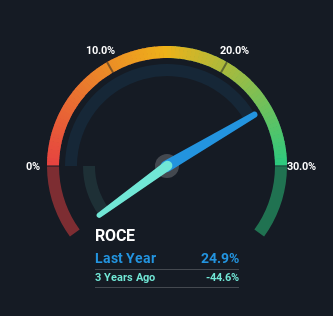
What are the early trends we should look for to identify a stock that could multiply in value over the long term? Ideally, a business will show two trends; firstly a growing return on capital employed (ROCE) and secondly, an increasing amount of capital employed. Ultimately, this demonstrates that it's a business that is reinvesting profits at increasing rates of return. With that in mind, the ROCE of Rafako (WSE:RFK) looks great, so lets see what the trend can tell us.
Return On Capital Employed (ROCE): What Is It?
Just to clarify if you're unsure, ROCE is a metric for evaluating how much pre-tax income (in percentage terms) a company earns on the capital invested in its business. The formula for this calculation on Rafako is:
Return on Capital Employed = Earnings Before Interest and Tax (EBIT) ÷ (Total Assets - Current Liabilities)
0.25 = zł47m ÷ (zł594m - zł405m) (Based on the trailing twelve months to September 2022).
Therefore, Rafako has an ROCE of 25%. That's a fantastic return and not only that, it outpaces the average of 13% earned by companies in a similar industry.
See our latest analysis for Rafako

While the past is not representative of the future, it can be helpful to know how a company has performed historically, which is why we have this chart above. If you'd like to look at how Rafako has performed in the past in other metrics, you can view this free graph of past earnings, revenue and cash flow.
What Can We Tell From Rafako's ROCE Trend?
We're pretty happy with how the ROCE has been trending at Rafako. We found that the returns on capital employed over the last five years have risen by 156%. The company is now earning zł0.2 per dollar of capital employed. In regards to capital employed, Rafako appears to been achieving more with less, since the business is using 65% less capital to run its operation. If this trend continues, the business might be getting more efficient but it's shrinking in terms of total assets.
For the record though, there was a noticeable increase in the company's current liabilities over the period, so we would attribute some of the ROCE growth to that. Effectively this means that suppliers or short-term creditors are now funding 68% of the business, which is more than it was five years ago. And with current liabilities at those levels, that's pretty high.
In Conclusion...
From what we've seen above, Rafako has managed to increase it's returns on capital all the while reducing it's capital base. Given the stock has declined 66% in the last five years, this could be a good investment if the valuation and other metrics are also appealing. So researching this company further and determining whether or not these trends will continue seems justified.
Rafako does come with some risks though, we found 4 warning signs in our investment analysis, and 2 of those don't sit too well with us...
If you want to search for more stocks that have been earning high returns, check out this free list of stocks with solid balance sheets that are also earning high returns on equity.
New: AI Stock Screener & Alerts
Our new AI Stock Screener scans the market every day to uncover opportunities.
• Dividend Powerhouses (3%+ Yield)
• Undervalued Small Caps with Insider Buying
• High growth Tech and AI Companies
Or build your own from over 50 metrics.
Have feedback on this article? Concerned about the content? Get in touch with us directly. Alternatively, email editorial-team (at) simplywallst.com.
This article by Simply Wall St is general in nature. We provide commentary based on historical data and analyst forecasts only using an unbiased methodology and our articles are not intended to be financial advice. It does not constitute a recommendation to buy or sell any stock, and does not take account of your objectives, or your financial situation. We aim to bring you long-term focused analysis driven by fundamental data. Note that our analysis may not factor in the latest price-sensitive company announcements or qualitative material. Simply Wall St has no position in any stocks mentioned.
About WSE:RFK
Rafako
Engages in the engineering business to the energy sector, and oil and gas sectors in Poland and internationally.
Medium-low with weak fundamentals.
Similar Companies
Market Insights
Community Narratives




